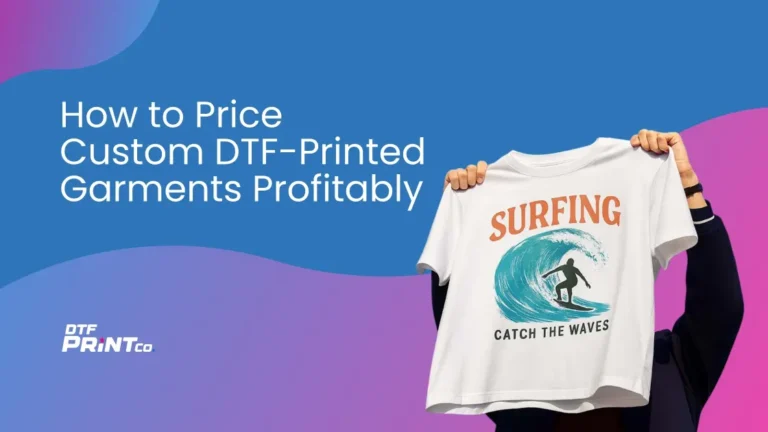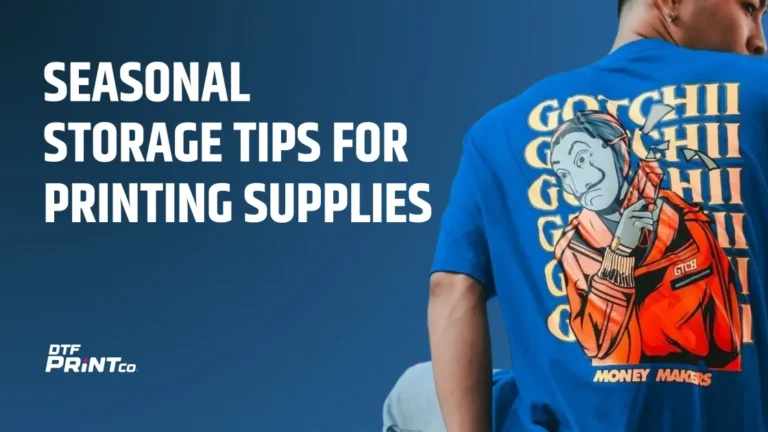Direct to Film printing, or DTF, has taken the custom apparel world by storm—and for good reason. It offers an incredibly flexible way to produce vibrant, durable prints on virtually any fabric. But if you’ve ever watched a tutorial or spoken to a supplier and found yourself lost in a sea of terms like “cold peel,” “RIP software,” or “white underbase,” don’t worry—you’re not alone.
In this guide, we’re cutting through the jargon. Whether you’re running a home-based print shop or building out a commercial apparel brand, this DTF printing glossary is your no-nonsense companion. We’ll break down the terminology, give real-world context, and explain why each concept matters to your print quality and business success.
What is DTF Printing—In Plain Terms?
DTF stands for Direct to Film printing, a relatively new and exciting method in the custom printing industry. Unlike Direct to Garment (DTG), which prints directly on fabric, DTF prints your design onto a special PET film. That design is then covered in adhesive powder, heat cured, and finally pressed onto a garment using a heat press.
Sounds simple enough, right? The real power of DTF lies in its versatility—it works on cotton, polyester, tri-blends, nylon, canvas, and even leather. That alone has made it a game-changer for anyone who sells apparel, tote bags, workwear, or promotional merch.
Why You Need a Glossary (Even If You’re Experienced)
Understanding DTF printing lingo isn’t just about sounding smart. These terms affect every part of the workflow—from choosing the right film and ink to maintaining your printer and avoiding waste.
Here’s the full glossary, broken down into sections you’ll actually use. If you’ve been confused by a term before, you’ll find clarity here.
Core DTF Terms and Their Meanings
PET Film: PET stands for polyethylene terephthalate—a type of plastic that’s specially coated for printing. It’s the base on which your design is printed. There are multiple kinds like cold peel PET film (you wait before removing the film), hot peel PET film (you peel it immediately after pressing), and double-sided coated film (great for higher ink absorption and vibrancy). Without the right film, your colors may not stick properly or may look faded.
Adhesive Powder (Hot Melt Powder): This powder is applied after printing and melts when heated. It’s what bonds your design to the fabric. Common types include fine (smoother finish), medium (standard for most garments), and coarse (better for thick materials like canvas).
CMYK+W Ink Configuration: CMYK stands for Cyan, Magenta, Yellow, and Black, with the W standing for White. These pigment-based inks are printed in sequence, with the white underbase laid last for opacity and color vibrancy.
White Underbase: This is the white ink layer printed under your colored image. It’s especially critical when printing on dark or patterned fabrics. The better your underbase alignment, the better your print quality.
DTF Printing Equipment: Know Your Tools
DTF Printer: These printers look like standard inkjet printers but are specially modified to handle DTF inks and PET film. Popular entry-level models include the L1800 or XP-15000, while larger shops might use industrial units like the STS Mutoh or Prestige L2. Printer upgrades may include roll-fed film feeds, vacuum platens, or bulk ink tanks.
RIP Software: RIP (Raster Image Processor) software helps control color profiles, print order (white layer vs color layer), and ink amounts. Popular RIPs include Cadlink Digital Factory, Acrorip, and EKPrint Studio.
Powder Shaker: This machine automates the powder-coating process, saving time and ensuring even coverage. Many models include built-in curing ovens to bake the powder after it’s applied.
Heat Press: This is where the final transfer happens. You’ll need a press that can hit consistent temperatures (usually between 300–320°F) with medium to high pressure. Swing-away presses give the most control. Also worth having: Teflon sheets, silicone pads, and press pillows for seams and zippers.
Key DTF Print Settings and Variables
Temperature: Heat press temperature affects adhesion and washability. The standard is 300–320°F. Some specialty powders or fabrics may require dialing it up or down.
Dwell Time: Most transfers press for 15–20 seconds. Less time can lead to poor adhesion, more can cause overmelting.
Pressure: Medium to firm pressure is key for embedding the adhesive into the garment fibers. Inconsistent pressure leads to cracked or spotty designs.
Humidity: Low humidity causes ink clogs. High humidity affects powder drying. Keep your space around 40–60% RH.
Print Maintenance Terms You Should Know
Nozzle Check: A basic maintenance step to ensure each ink color is printing properly. Run it daily if you’re printing regularly.
Head Cleaning: This clears dried ink or debris from your printer’s nozzles. Manual and automatic options available. Avoid over-cleaning—it wastes ink.
Ink Agitation: White ink tends to settle. Stir or shake it before printing. Some printers have built-in agitators that stir automatically.
Cap Station Cleaning: The cap station seals the print head when not in use. If it clogs, your head can dry out. Clean it weekly for consistency.
Advanced and Pro-Level DTF Terms
Vacuum Platen: Holds the PET film flat during printing using suction. Prevents film slippage and improves print registration.
Linear Rail System: Stabilizes print head movement, reducing vibration and improving image sharpness.
Bulk Ink System: Larger refillable tanks for ink. Reduces refill frequency and is ideal for high-volume production.
Wiper Blade: Cleans the print head during idle or post-print cycles to prevent ink build-up.
Capping Station: Keeps the print head moist when not printing, preventing clogging.
Anti-Static Rod: Removes static from PET film before printing. Static can interfere with ink drop placement.
Workflow Steps with Real-World Advice
Create and Export Design: Use Photoshop, Illustrator, or CorelDRAW to build your artwork. Export as .PNG with a transparent background for best results. Mirror the image in your RIP software before printing.
Print to PET Film: Load the film with the coated side up. Your printer will lay down colored ink followed by the white underbase.
Apply Adhesive Powder: Sprinkle hot melt powder evenly across the wet print. Tilt the film or use a shaker to remove excess. Coverage must be full but not excessive.
Cure the Powder: Hover your heat press or use an oven to melt the powder until it turns semi-glossy (about 2–3 minutes). If it looks grainy or rubbery, it’s under-cured.
Transfer to Garment: Place the film face-down on the fabric, cover with parchment paper, and press. Hot Peel means peel the film immediately while warm. Cold Peel means let it cool first before peeling.
Post-Press: Repress with parchment paper for 5–10 seconds to increase durability and improve finish.
How DTF Compares to Other Methods
DTF: Works on all fabric types, full-color, vibrant, soft hand, moderate learning curve.
DTG: Works mostly on cotton, better for photographic prints, requires pretreatment.
Sublimation: Best for light-colored polyester, ultra-soft feel, extremely durable.
Screen Printing: Great for bulk orders and bold colors, but time-consuming setup and limited color complexity.
Troubleshooting Common Terms and Fixes
Banding: Horizontal lines in your print—usually caused by clogged nozzles or low resolution. Clean heads and check your RIP settings.
Ink Bleed: Colors blending together—often due to poor film quality or excess moisture. Try using a different film or pre-pressing your garment longer.
Cracking: Happens when pressure or temperature is too low, or when powder curing is incomplete.
Ghosting: A faint duplicate image—caused by film movement during pressing. Secure the film properly and don’t open the press too early.
Delamination: Design peeling off—usually from poor adhesive coverage or using the wrong peel temperature.
DTF Acronyms You’ll Run Into
PET: Polyethylene Terephthalate – the base film
RIP: Raster Image Processor – software for print management
CMYK+W: Cyan, Magenta, Yellow, Black + White inks
TPU: Thermoplastic Polyurethane – material in hot melt powder
Bonus: Pro Tips from Our Print Room
Always pre-press garments to remove moisture—it improves adhesion. Use a lint roller before pressing. Dust affects bonding. Don’t skimp on adhesive powder. Uneven coverage is the number one cause of peeling. Store your PET films flat and in a dust-free environment. Clean your print heads twice a week—daily if you’re running white ink often.
FAQs
What’s the difference between DTF and DTG printing?
DTF prints onto film and then transfers to fabric, making it suitable for more materials. DTG prints directly onto cotton.
Can I use sublimation ink in a DTF printer?
No. DTF requires pigment inks that are designed to work with film and adhesive powder. Sublimation inks won’t bond properly.
How long do DTF transfers last?
Properly applied DTF prints can last over 50 washes with minimal fading if cured and pressed correctly.
What’s the best heat press temperature for DTF transfers?
300–320°F with medium to firm pressure, for 15–20 seconds, works best in most cases. Always test first.
Do I need a curing oven?
Not necessarily. A hover-style heat press works fine for small setups. Curing ovens are more efficient for high-volume work.
Conclusion: DTF Terminology = Print Mastery
Mastering the language of DTF printing is more than just an academic exercise—it’s a business advantage. Understanding the difference between hot and cold peel, knowing your RIP settings, or even troubleshooting banding issues can save you time, money, and headaches.
Print businesses that take the time to truly understand their tools are the ones that scale faster, deliver better products, and build loyal customers. Whether you’re just starting out or refining your process, this glossary should be your go-to reference as you grow.






